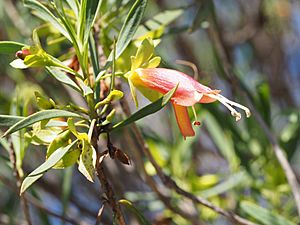Pixie bush facts for kids
Quick facts for kids Pixie bush |
|
|---|---|
 |
|
| Eremophila oldfieldii subsp. oldfieldii leaves and flowers | |
| Scientific classification | |
| Genus: |
Eremophila (plant)
|
| Species: |
oldfieldii
|
| Synonyms | |
|
|
The Pixie Bush (scientific name: Eremophila oldfieldii) is a beautiful flowering plant. It belongs to the figwort family. This plant is special because it only grows naturally in Western Australia. The Pixie Bush can be a shrub or a small tree. It has rough bark and pretty red, orange, or yellow flowers. Its leaves can be wide and flat, or narrow and thick.
Contents
What Does the Pixie Bush Look Like?
The Pixie Bush is usually a rounded shrub. It can grow up to about 2.5 meters (8 feet) tall. Sometimes, it grows into a small tree. These trees can reach about 6 meters (20 feet) in height. They have rough, grey-brown bark.
Leaves and Flowers
The leaves grow one after another along the branches. They are usually between 30 and 110 millimeters (1 to 4 inches) long. The shape and width of the leaves depend on the type of Pixie Bush.
- One type has thin, flat leaves. These leaves are narrow and shaped like a spear or oval. They are about 3 to 9.5 millimeters (0.1 to 0.4 inches) wide.
- Another type has thick, narrow, and fleshy leaves. These leaves are more like cylinders. They are about 1.1 to 2.5 millimeters (0.04 to 0.1 inches) wide.
The flowers grow one by one where the leaves meet the stem. They sit on a smooth, S-shaped stalk. This stalk is about 8 to 35 millimeters (0.3 to 1.4 inches) long. Each flower has five sepals, which are like small leaves that protect the bud. These sepals are green or brown and are also 8 to 35 millimeters long.
The petals of the flower are joined together at the bottom. They form a tube that is 18 to 40 millimeters (0.7 to 1.6 inches) long. The outside of this tube is smooth and can be red, orange, or yellow. The edges and inside of the petals have tiny, sticky hairs. There are four stamens (the parts that make pollen) that stick out from the flower tube.
When Does it Flower?
Pixie Bushes usually flower from May to October. After the flowers, small fruits appear. These fruits are almost round and look wrinkled. They are smooth and about 3 to 5 millimeters (0.1 to 0.2 inches) long. They have a thin, papery covering.
How Was the Pixie Bush Named?
The first official description of the Pixie Bush was written in 1859. A botanist named Ferdinand von Mueller published it in a book called Fragmenta phytographiae Australiae. The plant's specific name, oldfieldii, honors Augustus Frederick Oldfield. He was the person who first collected this type of plant.
Different Types of Pixie Bush
Scientists have described two main types, or subspecies, of the Pixie Bush:
- Eremophila oldfieldii subsp. oldfieldii: This type has thin, flat leaves.
- Eremophila oldfieldii subsp. angustifolia: This type has thick, narrow, and fleshy leaves.
There's also a third, very rare type. It was found in 2010 and is called Eremophila oldfieldii subsp. Karara. This type only grows near Rothsay. It is listed as "Priority One" by the Government of Western Australia. This means it's known from only a few places and might be at risk.
Where Does the Pixie Bush Grow?
The first type, Eremophila oldfieldii subsp. oldfieldii, is common and found in many places. It grows in clay, loam, or sandy soils that contain lime. You can find it between Wongan Hills and Shark Bay. It grows in several different natural areas of Western Australia.
The second type, Eremophila oldfieldii subsp. angustifolia, grows in rocky areas. It is found between Kalgoorlie and Cue. This type also grows in several natural regions, including parts of the Great Victoria Desert.
Is the Pixie Bush Protected?
The two main types of Pixie Bush are not considered to be in danger. The Government of Western Australia Department of Parks and Wildlife has classified them as "not threatened."
Growing Pixie Bush in Your Garden
The Pixie Bush is a great plant for gardens. Its bright red flowers really stand out against its dark green leaves. It's a tough plant that can handle different conditions. People use it as a windbreak or to create a screen in their gardens.
You can grow new Pixie Bushes from cuttings. Cuttings are small pieces of the plant that can grow roots. This plant can grow in many types of soil. It likes full sun or a little bit of shade. It doesn't need much water once it's established. However, very cold frosts might damage it.
Images for kids
-
E. oldfieldii subsp. angustifolia growing near Leonora




